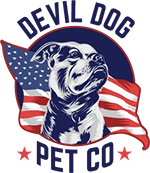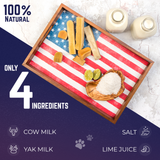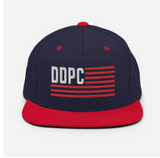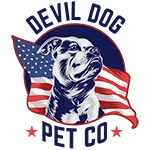Key Takeaways
- Benadryl spray provides quick relief for minor skin irritations, bug bites, and hot spots in dogs.
- The topical diphenhydramine works by blocking histamine receptors locally, reducing itching within 5-10 minutes.
- Benadryl spray is unsafe for puppies under 12 weeks, pregnant or nursing dogs, and dogs with heart conditions.
- Always supervise the application of Benadryl spray and prevent your dog from licking the treated area for 30-45 minutes.
Table of Contents
- What Is Benadryl Spray for Dogs, And Does It Belong in Your First-Aid Kit?
- When Should You Use Benadryl Spray on a Dog? Scenarios & Limitations
- How to Apply Benadryl Spray on a Dog, Step-by-Step Leadership Techniques
- Benadryl Spray Dosage for Dogs: Calculations, Adjustment Factors, and Avoiding Overdose
- Top 5 Tips for Using Benadryl Spray Safely, Lessons from the Devil Dog Field Team
- Benadryl Spray vs. Other Allergy Solutions for Dogs, Comparison Analysis
- Side Effects, Reactions & What to Do If Your Dog Licks Benadryl Spray
- Who Should Avoid Benadryl Spray? Contraindications and Leadership Calls
- Best Benadryl Sprays and Alternatives for Dogs in 2025
Benadryl Spray for Dogs: Mission-Ready Relief or Risk?
What Is Benadryl Spray for Dogs, And Does It Belong in Your First-Aid Kit?
Definition, Active Ingredient & Topical Delivery
Benadryl spray for dogs contains diphenhydramine as its active ingredient, typically in concentrations of 1-2% mixed with carriers like water, alcohol, or zinc oxide. Unlike human formulations that may include numbing agents like benzocaine, veterinary-safe versions stick to pure antihistamine delivery. The spray format allows immediate application to specific problem areas without the delayed onset of oral medications.
Most over-the-counter Benadryl sprays are FDA-approved for human use but commonly used off-label for canines under veterinary guidance. True veterinary-labeled sprays undergo additional safety testing for animal skin absorption rates and toxicity thresholds, making them the gold standard for responsible owners.
For acute issues like bee stings or contact dermatitis from poison ivy, this rapid local action can prevent minor irritations from escalating into major skin trauma from excessive scratching and licking. If your dog’s itching is stress-induced or you need a safe distraction during recovery, Beast - Himalayan Dog Chew and Extra Large (XL) Whole Elk Antler Official Dog Chew are excellent choices for redirecting anxious energy and supporting dental health.
When Should You Use Benadryl Spray on a Dog? Scenarios & Limitations

Canine Use Cases in the Field
Deploy benadryl spray for dogs for sudden-onset skin irritations: wasp stings on paws during hikes, mosquito bite clusters after evening walks, or hot spots that appear overnight. The three-minute rule applies, spray within three minutes of a sting or bite for maximum anti-inflammatory effect before histamine fully activates local immune responses.
Minor allergic rashes from new detergents, seasonal pollen exposure, or brief contact with irritating plants also respond well to targeted spray application. The key is catching these issues early, before bacterial secondary infections or deep tissue inflammation set in.
If you’re interested in learning more about safe, natural chews that can help manage anxiety-based itching, Himalayan Dog Yak Chews offer a nutritious and long-lasting option for most breeds.
Limits of Benadryl Spray for Dogs
Never use Benadryl spray on open wounds, oozing hot spots, or areas with broken skin, absorption through compromised barriers can cause systemic toxicity. It's also ineffective against serious allergic reactions requiring immediate veterinary intervention, like facial swelling, difficulty breathing, or full-body hives indicating anaphylaxis.
Pregnant dogs, nursing mothers, and puppies under 12 weeks lack the liver enzyme systems to process diphenhydramine safely. Dogs with glaucoma, heart conditions, or urinary retention issues can experience dangerous complications from even topical antihistamine absorption.
Why Immediate Action and Owner Judgement Matter
Extreme Dog Leadership means recognizing the difference between first-aid and veterinary emergencies. Benadryl spray serves as a tactical response tool, not a cure-all replacement for professional diagnosis and treatment. Your leadership filters every decision: is this a minor irritation I can manage, or symptoms requiring immediate professional intervention?
How to Apply Benadryl Spray on a Dog, Step-by-Step Leadership Techniques
Pre-Application Prep
Clean the affected area with saline solution or plain water, never hydrogen peroxide, which can worsen inflammation. Clip surrounding fur if matted or thick enough to prevent spray contact with skin. Pat the area completely dry with a clean cloth; wet skin dilutes the medication and increases absorption unpredictably.
Applying the Spray
Shake the bottle vigorously for 10 seconds to ensure even diphenhydramine distribution. Hold 2-4 inches from the affected area and spray for 2-3 seconds maximum, enough to lightly wet the skin without soaking. For a 30-pound dog, this translates to approximately 1-2 milliliters or a pea-sized coverage area. Never exceed three applications in 24 hours, and limit coverage to less than 10% of your dog's total body surface.
Benadryl Spray Dosage for Dogs: Calculations, Adjustment Factors, and Avoiding Overdose
Calculating a Safe Topical Dose
Weight-based dosing for benadryl spray for dogs follows simple math: 1-2 mg of diphenhydramine per 10 pounds of body weight per application site. A 50-pound dog with a hot spot on the flank can safely receive up to 10 mg topically, roughly equivalent to a quarter-sized spray pattern. Toy breeds under 15 pounds require extra caution; limit to pinpoint application and monitor for absorption signs like excessive drowsiness or agitation.
For more on how breed and size affect safe chew and treat choices, see this comprehensive comparison of deer antler vs elk antler for dogs.
When Topical Dose Isn't Enough (and When It's Too Much)
Never combine benadryl spray for dogs with oral diphenhydramine without veterinary approval, cumulative sedation and anticholinergic effects can overwhelm smaller dogs or those with compromised liver function. If localized itching spreads or facial swelling develops, topical application has reached its limits. Escalate to professional care rather than increasing frequency or coverage area.
Factors That Change the Math
Puppies under 12 weeks, pregnant females, and seniors with kidney disease absorb topical medications unpredictably. Thin-skinned breeds like Whippets or dogs with compromised skin barriers from allergies require reduced dosing, start with half the standard amount. Dogs on medications like heparin or certain antifungals may experience enhanced diphenhydramine effects, making veterinary consultation mandatory before first use.
Top 5 Tips for Using Benadryl Spray Safely, Lessons from the Devil Dog Field Team

Field-tested wisdom from Marine handlers and veterinary partners who've managed everything from training injuries to emergency allergic reactions. These protocols separate responsible dog leaders from reactive owners.
1. Check the label for diphenhydramine only. Avoid sprays containing benzocaine, lidocaine, or high alcohol content, these compounds can cause contact dermatitis or toxicity in dogs. Human formulations often include additives unsafe for canine use.
2. Never spray on broken or oozing skin. Open wounds absorb medication rapidly, increasing overdose risk. Clean, intact skin only, if you see blood, pus, or deep scratches, switch to saline rinse and veterinary evaluation.
3. Monitor for side effects within 30 minutes. Watch for sedation, unsteady walking, dilated pupils, or paradoxical agitation. These signs indicate systemic absorption and require immediate spray discontinuation.
4. Rotate remedies for anxiety-based itching. Stress-driven scratching needs behavioral intervention, not just symptom suppression. Devil Dog antler chews or yak chews redirect nervous energy while supporting dental health, address the root cause. For a long-lasting, high-protein option, try the Monster - Himalayan Dog Chew.
5. Vet-first mindset on recurring issues. If the same spot needs benadryl spray for dogs more than twice weekly, underlying conditions like bacterial infections or environmental allergies require professional diagnosis and treatment.
Benadryl Spray vs. Other Allergy Solutions for Dogs, Comparison Analysis
Smart leaders evaluate all options before committing to a treatment protocol. Each solution serves specific scenarios, and understanding their strengths prevents both under-treatment and overmedication.
| Solution | Onset Time | Duration | Application | Best For | Limitations |
|---|---|---|---|---|---|
| Benadryl Spray | 5-10 minutes | 1-3 hours | Direct topical | Acute hot spots, bug bites | Limited coverage area |
| Oral Benadryl | 30-60 minutes | 4-8 hours | By mouth | Systemic reactions | Sedation risk |
| Hydrocortisone Spray | 5-15 minutes | 4-12 hours | Direct topical | Inflammatory skin conditions | Steroid concerns long-term |
| Prescription (Apoquel/Cytopoint) | 1-12 hours | 4-8 weeks | Oral/injection | Chronic allergies | Cost, vet monitoring required |
When to Reach for Each Option
Benadryl spray for dogs excels in acute situations, bee stings during hikes, sudden hot spots after grooming, or contact reactions from new bedding. Choose oral diphenhydramine for systemic reactions like hives covering multiple body areas, but only under veterinary dosing guidance. Reserve prescription medications for chronic conditions requiring long-term management, where cost justifies sustained relief.
Real-World Application Scenarios
Leadership means matching the tool to the mission. Use benadryl spray for targeted, rapid relief, but for ongoing itch management or dogs prone to boredom, Large Whole Elk Antler Official Dog Chew can help redirect destructive behaviors and support healthy chewing habits.
Side Effects, Reactions & What to Do If Your Dog Licks Benadryl Spray
Even responsible application can trigger unexpected reactions. Your leadership means recognizing warning signs and responding decisively.
Local and Systemic Side Effects to Monitor
Local reactions appear at the application site within 15-30 minutes: increased redness, swelling, or paradoxical worsening of itching. These signal skin sensitivity or allergic response to diphenhydramine itself.
Systemic effects emerge when the drug absorbs through skin into bloodstream: drowsiness, dry mouth, dilated pupils, or unusual agitation. Thin-skinned areas like belly or inner thighs increase absorption risk. Senior dogs and puppies show heightened sensitivity.
For a scientific overview of diphenhydramine’s pharmacology and safety, see this detailed resource on diphenhydramine.
Solutions for Accidental Licking or Overuse
If your dog licks treated areas before the 30-minute absorption window:
Immediate Action Protocol: Rinse mouth with cool water for 60 seconds. Offer small amounts of plain water to dilute residual taste. Monitor for drooling, vomiting, or excessive sedation over the next 3 hours. Contact your veterinarian if symptoms persist beyond this timeframe.
Eye contact requires immediate flushing with lukewarm water for 5+ minutes. Hold the eyelid open gently while irrigating from inner to outer corner. Seek veterinary evaluation if redness, squinting, or discharge continues past 2 hours.
Recognizing Overdose and Emergency Response
Critical warning signs: Hyperactivity followed by extreme lethargy, tremors, rapid or labored breathing, or loss of coordination. These indicate diphenhydramine toxicity requiring immediate veterinary intervention.
Call the ASPCA Animal Poison Control Center at (888) 426-4435 or your emergency veterinarian. Have the product label, your dog's weight, and estimated amount applied ready for the consultation.
Who Should Avoid Benadryl Spray? Contraindications and Leadership Calls

Extreme Dog Leadership means knowing when to step back. Certain dogs face elevated risks that outweigh potential benefits.
High-Risk Cases and Medical Contraindications
Absolute contraindications: Pregnant or nursing females, dogs with glaucoma, severe heart disease, or known diphenhydramine allergies. The drug crosses placental barriers and appears in milk, potentially affecting developing puppies.
Relative contraindications require veterinary consultation first: dogs with enlarged prostate, urinary retention, severe liver or kidney disease, or those taking medications like epinephrine, heparin, or certain antifungals. Drug interactions can amplify side effects unpredictably.
Breed and Size Considerations
Toy breeds under 10 pounds face higher overdose risk due to increased surface-area-to-body-weight ratios. Their thin skin absorbs topical medications more readily than larger breeds.
Brachycephalic breeds (bulldogs, pugs, Boston terriers) with compromised breathing shouldn't receive any medication that could cause additional respiratory depression without direct veterinary oversight.
For more on the pros and cons of antler chews for different breeds, check out are antlers for dogs a good idea.
Decision-Making Framework for Responsible Owners
Apply the "Three Checks" before any application: Review your dog's medical history for contraindicated conditions, verify no conflicting medications, and assess the affected area's sensitivity level. When in doubt, choose the conservative path, your dog's long-term health trumps immediate convenience.
Best Benadryl Sprays and Alternatives for Dogs in 2025
Quality varies dramatically across brands. Choose products with veterinary backing and transparent ingredient lists.
Top Veterinary-Recommended Options
Vetadryl Spray leads with 2% diphenhydramine in alcohol-free formula. Best for: Sensitive skin and first-time users needing gentle introduction to topical antihistamines.
Benadryl Extra Strength Anti-Itch Spray offers higher concentration for stubborn hot spots. Best for: Thick-coated breeds where standard strength doesn't penetrate effectively. Avoid near mucous membranes due to increased potency.
Alternative Itch Relief Solutions
Hydrocortisone sprays provide anti-inflammatory action without antihistamine effects. Best for: Dogs with confirmed diphenhydramine sensitivity or inflammatory skin conditions rather than allergic reactions.
Colloidal oatmeal-based sprays offer natural soothing without drug interactions. Best for: Chronic skin conditions requiring daily management or dogs on multiple medications where drug interactions pose concerns.
When Chews Beat Chemicals
Stress-induced scratching responds better to mental redirection than topical treatments. Large - Split Elk Antler Dog Chew - 1 Pack provides sustained engagement that interrupts obsessive licking cycles. Large - Himalayan Dog Chew - 3 Pack offers digestible protein rewards that satisfy anxiety-driven oral fixation while supporting skin health through balanced nutrition.
For dogs whose itching stems from boredom or separation anxiety, addressing the root behavioral cause with appropriate chews and enrichment is often more effective than relying solely on topical medications. For additional expert advice on maintaining your pet’s dental health, see these tips for taking care of your dog's teeth.
For further reading on antihistamines and their use in veterinary medicine, consult this FDA resource on antihistamines.
Frequently Asked Questions
What are the safe and appropriate situations to use Benadryl spray on dogs?
Benadryl spray is best for quick relief of minor skin irritations, insect bites, and hot spots. Use it on localized areas to reduce itching and inflammation caused by contact dermatitis or bug stings, especially during outdoor activities.
Why is Benadryl spray not recommended for puppies under 12 weeks, pregnant or nursing dogs, and dogs with heart conditions?
Puppies under 12 weeks, pregnant or nursing dogs, and dogs with heart issues have more sensitive systems and different metabolism, making them vulnerable to adverse reactions from diphenhydramine. Avoiding use in these groups prevents potential toxicity or complications.
How should Benadryl spray be applied to ensure effectiveness and prevent adverse reactions in dogs?
Apply Benadryl spray directly to the affected area, avoiding open wounds or mucous membranes. Use a light spray, then supervise your dog to prevent licking for 30–45 minutes, ensuring the medication absorbs and reduces itching safely.
What precautions should be taken if a dog licks the area treated with Benadryl spray?
If your dog licks the treated spot, monitor for signs of excessive drooling, vomiting, or lethargy. Prevent licking by distracting your dog or using an Elizabethan collar if needed, and contact your veterinarian if any unusual symptoms appear.






